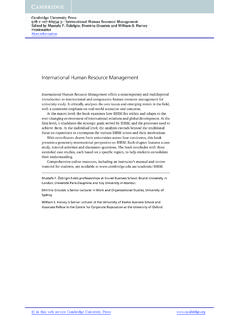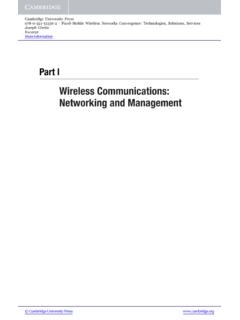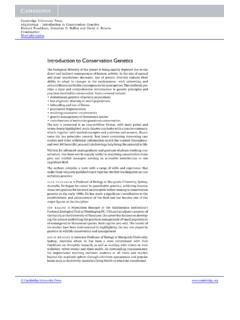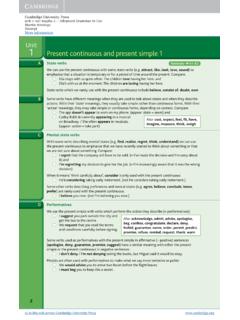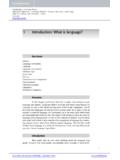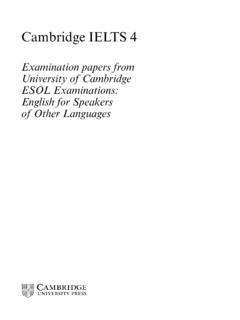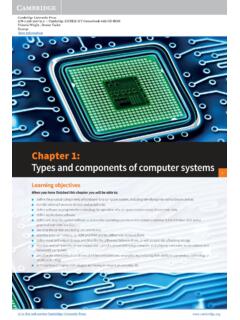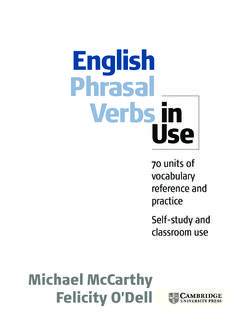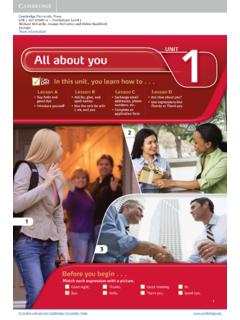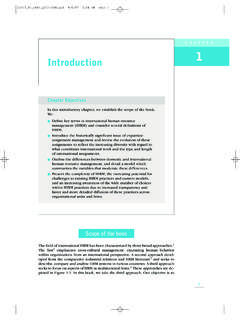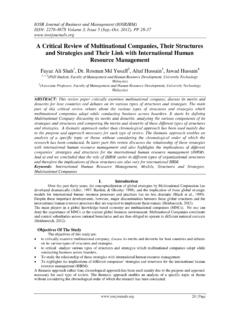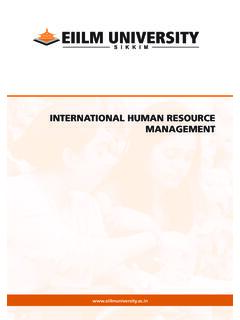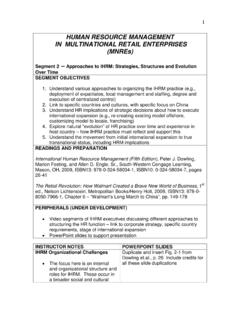Transcription of Introduction: a multilevel approach to international …
1 Introduction: amultilevel approachto internationalhuman resourcemanagementMustafa F. O zbilgin,Dimitria Groutsisand William S. Harvey1 Cambridge University Press978-1-107-66954-3 - international human resource ManagementEdited by Mustafa F. zbilgin, Dimitria Groutsis and William S. HarveyExcerptMore in this web service Cambridge University PressInternational human resource management (IHRM) is a set of management inter-ventions and activities crafted for the effective practice of recruitment, retention,deployment, development and use of human resources in an international study of IHRM requires attention to the relationships that shape the dynamics ofinputs, processes and outputs of human resource management (HRM) among a set ofactors at international , national, sectoral, organisational, team and individual multiplicity of key actors and complexity of relationships often complicate ourunderstanding of how IHRM policy and practice develop. To overcome this complex-ity, we offer a multilevel and multidimensional approach to the study of a multilevel approach to IHRMIn this book, we present a novel multilevel approach to the study of IHRM, incorpo-rating in each chapter the macro-, meso- and micro-levels at which IHRM policy isshaped, negotiated, refined and concernsAt the macro-level, we explore four central concerns.
2 First, we examine the contextof global and international relations for IHRM, guided by the stage of a company sinternationalisation and the type of business concern it represents. We incorporatedefinitions and explanations of the simple import export relationship, joint ventures,mergers and acquisitions as well as expansion into foreign markets such as offshoringand outsourcing, in exploring how macro-level drivers are operationalised in meso-level organisational policy and practice. We also examine globalisation and providean in-depth assessment of what the increased mobility of financial capital, goods,services and people means for IHRM in practice. Second, we outline the relationsbetween foreign markets and governments as well as between key stakeholdersin multiple business entities. Third, we assess the workings of international labourstandards, laws, policies and processes in play between host, home and third , we present a substantive debate on ethical issues and dilemmas, guided bydebates on localisation versus standardisation and global convergence or concernsAt the meso-level, chapters focus on implications and concerns of organisationalinfrastructure, primarily examining them across two dimensions: first, we studyorganisational resources (financial, human , social and cultural) by examining short,medium and long-term agendas and strategic versus reactive approaches.
3 Second, wescrutinise IHRM processes, including recruitment and selection, from the perspectiveof the host-country national (HCN), the parent-country national (PCN) and the third-country national (TCN) as well as the high-skilled migrant. We take into accountworkforce planning; training and development; cross-cultural training; cross-culturalINTERNATIONAL human resource MANAGEMENT2 Cambridge University Press978-1-107-66954-3 - international human resource ManagementEdited by Mustafa F. zbilgin, Dimitria Groutsis and William S. HarveyExcerptMore in this web service Cambridge University Pressawareness; diversity management ; performance management ; remuneration; repat-riation, international labour relations (ILR), corporate social responsibility, corp-orate reputation and international laws and concernsOur micro-level assessment of IHRM concerns focuses on the international assigneefrom three dimensions. First, we examine different types of expatriate (also knownas PCNs), HCNs, TCNs, business travellers and self-identified migrants.
4 Second, weaccount for increased demand for skills internationally (global war for talent ). Third,we identify the demographic faultlines that international managers must considerin the recruitment and selection process; the management of international talent; andthe expectations both of management and international assignees between levelsOur novel multilevel and multidimensional approach enables a focus on the interplaybetween the three levels of macro, meso and micro concerns. Recognising this, weexplore a number of demographic shifts, including changes in generational patterns,gender dynamics, work life arrangements and migration repertoires, as well as social,economic and political transformations around demographic change. We illustratehow organisational policies interpret such macro-level demographic changes andchange them for individual multilevel approach to IHRM is useful in bringing together three levels ofconsideration, previously treated separately in the literature: first, international linksbetween the home and host country; second, the organisational expectations andrequirements of the home and host countries; and third, the individual expectations,requirements and characteristics of the international multilevel framework offers a comprehensive understanding of the role ofhuman resource (HR) managers in the international context.
5 In providing this under-standing, we bridge the gap between two IHRM literatures that have been polarisedbetween a bird s-eye view of IHRM drivers in the global context and a more limitedview of IHRM as merely a set of issues for expatriate management . We do so byexploring the interplay between organisational, team and individual-level consider-ations, in the context of international and national drivers, rules and is this book innovative?This book seeks to innovate in several ways. First, we extend the literature beyond thetraditional focus on understanding HRM processes in the international , we examine the role of HCNs and TCNs as well as changing immigrationpolicies, which enable the international mobility of skilled migrants (SMs), such asINTRODUCTION3 Cambridge University Press978-1-107-66954-3 - international human resource ManagementEdited by Mustafa F. zbilgin, Dimitria Groutsis and William S. HarveyExcerptMore in this web service Cambridge University Press self-initiated expatriates (SIEs), who have been little-scrutinised to date.
6 Here, wealso provide insights into the definition of expatriates by disaggregating them alongmultiple identity lines. Third, we transcend the limited focus of cross-cultural man-agement by considering the importance of diversity management techniques andstrategies, in the context of IHRM responsibilities within and between different spatialcontexts. Fourth, we depict regional trends, including details on labour mobility,activity in multinational companies (MNCs) and IHRM processes in practice in multi-ple geographic contexts. Fifth, we provide students with a useful source book, linkingthem to the latest data and information from a variety of sources. Finally, we engagestudents with the business media, as we link chapters to current public eventsreported in the high-quality business media as a way of encouraging students tointeract critically with contemporary debates in the this text is pitched at undergraduate students, it is also intended to be accessibleto postgraduates, practitioners and scholars new to the field.
7 Key concepts from theIHRM literature are clearly defined, helping readers to grasp core ideas and practicesfrom the field. We have drawn our contributor team from a wide range of countriesacross four continents, illustrating our commitment to making the book truly interna-tional. The authors are also a diverse group of people, whether in terms of gender,ethnicity, age, discipline or other categories. international authorship and examplesensure that the text is highly accessible to readers from a range of of the bookThe text comprises 12 chapters, planned to suit a standard one-semester course. Eachchapter is packed with pedagogical and interactive features that engage readers andencourage directed and independent study, including concise introductions andsummaries; quick take-home messages ; current, real-world case studies; questionsfor discussion; and extensive recommendations for further reading. Each of thechapters is summarised 1: Global trends in international human resource management (Rofcanin,Imer and Zingoni).
8 The chapter discusses shifts in the global context in terms ofdemographic changes, institutional arrangements and individual values and 2: Cross-cultural and diversity management intersections: lessons forattracting and retaining international assignees (Groutsis, Ng and Ozturk). Theauthors bring a fresh perspective to the cross-cultural management field by exploringhow organisations need to transcend a monolithic understanding of cultures and tomove beyond prescriptive approaches towards locally tailored 3:Key players in international human resource management (Hollinshead,Forson, Rocha-Lawton and Calveley). This chapter shows that international players inINTERNATIONAL human resource MANAGEMENT4 Cambridge University Press978-1-107-66954-3 - international human resource ManagementEdited by Mustafa F. zbilgin, Dimitria Groutsis and William S. HarveyExcerptMore in this web service Cambridge University Pressthe IHRM domain are changing, rendering the old world order defunct.
9 The authorsexplain how IHRM policy and practice should capture the dynamism in shifts of power,resistance and contestation among new and old actors in the 4: Recruitment and selection in the international context (Potoc nik,Latorre, Dereli and Tacer). This chapter explains how recruitment and selectionpractices can be improved with better job analyses. The authors present a range ofconsiderations and activities for international organisations to improve their recruit-ment and selection 5: Cross-cultural training and development for overseas assignments(Berber, Rofcanin and Fried). The authors explore shifts in the career strategies ofworkers as well as career management approaches of organisations in the interna-tional 6: international reward (Jenkins). This chapter provides a review of thechanging context, approaches and repertoires of reward in the international 7: Employee retention (Balta). Balta reviews strategies for planning, choos-ing and implementing effective retention strategies in international 8: international labour relations (O zbilgin).
10 O zbilgin reviews ILR andinternational labour standards (ILS), exploring a number of different approaches andcontemporary 9: Reputation in the international context (Harvey). Harvey focuses onhow individual, group and organisational reputation is viewed, assessed andmanaged in the international 10: Expatriation and repatriation in the Asia Pacific region (Caven, Kirkand Wang-Cowham). The authors introduce the drivers for international mobilityof talent and focus in the case of the Asia Pacific 11: Balancing inflows and outflows in the European context(Vassilopoulou, Samaluk and Seierstad). This chapter reviews inflows and outflowsof labour and highlights relevant practice for IHRM through a focus on the 12: Self-initiated expatriation: case study lessons from Africa and theUnited States (Tatli, Berry, Ipek and April). The authors discuss how, why and underwhat circumstances individuals manage their own migration, with reference to NorthAmerican and African , in a conclusion by the book s editors (O zbilgin, Groutsis and Harvey), wesummarise the book and highlight the major contributions of each University Press978-1-107-66954-3 - international human resource ManagementEdited by Mustafa F.
